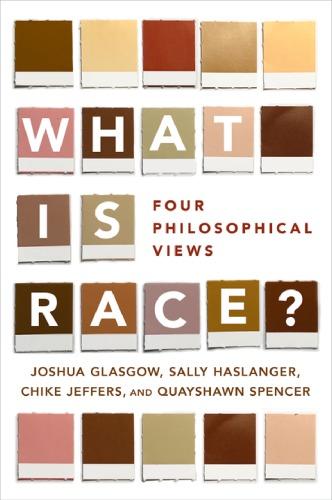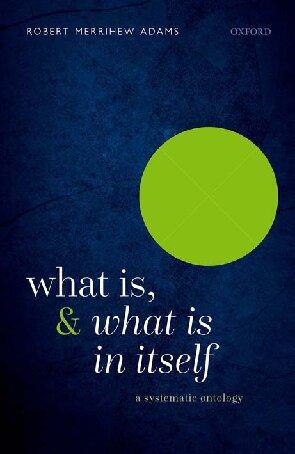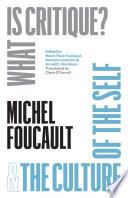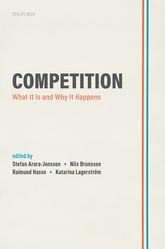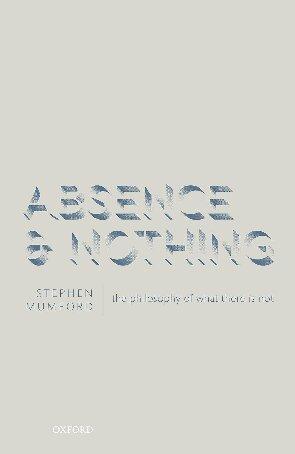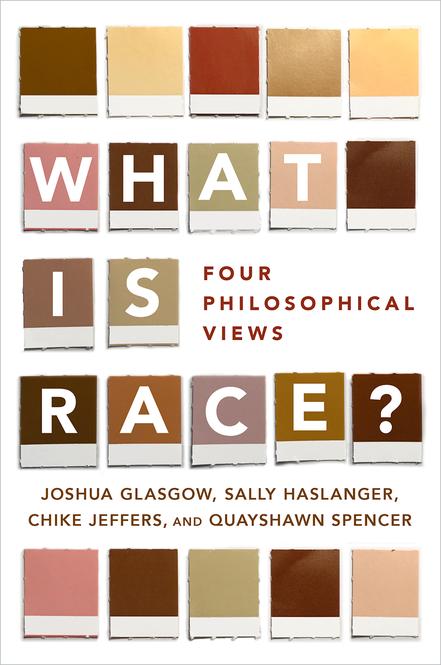WHAT IS RACE?
Four Philosophical Views
Joshua Glasgow
Sally Haslanger
Chike Jeffers
Quayshawn Spencer
Oxford University Press is a department of the University of Oxford. It furthers the University’s objective of excellence in research, scholarship, and education by publishing worldwide. Oxford is a registered trade mark of Oxford University Press in the UK and certain other countries.
Published in the United States of America by Oxford University Press 198 Madison Avenue, New York, NY 10016, United States of America.
© Oxford University Press 2019
All rights reserved. No part of this publication may be reproduced, stored in a retrieval system, or transmitted, in any form or by any means, without the prior permission in writing of Oxford University Press, or as expressly permitted by law, by license, or under terms agreed with the appropriate reproduction rights organization. Inquiries concerning reproduction outside the scope of the above should be sent to the Rights Department, Oxford University Press, at the address above.
You must not circulate this work in any other form and you must impose this same condition on any acquirer.
Library of Congress Cataloging-in-Publication Data
Names: Glasgow, Joshua, author. | Haslanger, Sally Anne, author. | Jeffers, Chike, 1982– author.
Title: What is race? : four philosophical views / Joshua Glasgow, Sally Haslanger, Chike Jeffers, Quayshawn Spencer/
Description: New York : Oxford University Press, 2019. | Includes bibliographical references and index.
Identifiers: LCCN 2018053834 (print) | LCCN 2019007102 (ebook) | ISBN 9780190610210 (Online content) | ISBN 9780190610197 (updf) | ISBN 9780190610203 (epub) | ISBN 9780190610173 (hardback) | ISBN 9780190610180 (paperback)
Subjects: LCSH: Race--Philosophy. | Race relations--Philosophy. | BISAC: PHILOSOPHY / Political. | PHILOSOPHY / Metaphysics. | PHILOSOPHY / Movements / General.
Classification: LCC HT1523 (ebook) | LCC HT1523 .G643 2019 (print) | DDC 305.8001—dc23
LC record available at https://lccn.loc.gov/2018053834
9 8 7 6 5 4 3 2 1
Paperback printed by Sheridan Books, Inc., United States of America
Hardback printed by Bridgeport National Bindery, Inc., United States of America
To our children, Samantha Rose Glasgow-Shulman, Aminata Lilla Jeffers, Ayo Jelani
Jeffers, Aza Katherine Ida Jeffers, Julian Buo-Hon Spencer, Quentin
Buo-Yi Spencer, Isaac Amazu Haslanger Yablo, and Zina Siyasa Haslanger Yablo, in the hope that their generations will find a more just world.
4. Is Race an Illusion or a (Very) Basic Reality?—Joshua Glasgow
5. Haslanger’s Reply to Glasgow, Jeffers, and Spencer
6. Jeffers’s Reply to Glasgow, Haslanger, and Spencer
7. Spencer’s Reply to Glasgow, Haslanger, and Jeffers
8. Glasgow’s Reply to Haslanger, Jeffers, and Spencer
ACKNOWLEDGMENTS
The theories presented in this book are derived from articles and books that we have previously published. Numerous people helped us as we developed those earlier publications. We would like to reaffirm our gratitude for their help.
With respect to the present work, we gratefully acknowledge the following:
Sally Haslanger would like especially to thank the other authors of the book, Joshua Glasgow, Chike Jeffers, and Quayshawn Spencer, for their ongoing work, helpful conversations, and friendly collaboration in putting this book together. In addition, she would like to thank Lawrence Blum, Jorge Garcia, Adam Hosein, Karen Jones, Lionel McPherson, Megan Mitchell, José Jorge Mendoza, Deborah Mühlebach, David Plunkett, Laura Schroeter, Francois Schroeter, Greg Restall, Tommie Shelby, Isaac Yablo, Stephen Yablo, and Zina Yablo for ongoing conversations on the topics discussed.
Chike Jeffers would like to thank Linda Martín Alcoff, Veromi Arsiradam, Tiffany Gordon, Tyler Hildebrand, David Ludwig, Tina Roberts-Jeffers, Katie Stockdale, and his coauthors Sally Haslanger, Quayshawn Spencer, and Joshua Glasgow for their feedback on drafts of his chapters in this book. He also presented versions of Chapter 2 at the University of Memphis and at Northwestern University. He is thankful to all who were present and especially to those who provided feedback on those occasions.
Quayshawn Spencer is thankful for feedback from Mariana Achugar, Linda Alcoff, Elizabeth Anderson, Luvell Anderson, Robert Brandon, Liam Bright, Mazviita Chirimuuta, Haixin Dang, Michael Devitt, Brian Epstein, Patrick Forber, Justin Garson, Joshua Glasgow, Michael Hardimon, Sally Haslanger, Jay Garfield, Chike Jeffers, Saul Kripke, Meena Krishnamurthy, Edouard Machery, Lionel McPherson, Charles Mills, Sandra Mitchell, Jennifer Morton, Albert Mosley, Wayne Norman, Sumeet Patwardhan, George Smith, and Daniel Wodak. He would also like to thank the faculty
and students in the philosophy departments at the following universities for allowing him to receive feedback on drafts of his chapters at a colloquium talk: Carnegie Mellon University, College of the Holy Cross, CUNY Graduate Center, Drexel University, Duke University, the University of Michigan at Ann Arbor, Smith College, Temple University, Tufts University, University of Maryland in Baltimore County, and Virginia Polytechnic Institute. Also, Spencer would like to thank the participants of the University of Pittsburgh’s Summer Program in Philosophy of Science for Underrepresented Groups in 2017 for all of their useful feedback on Chapter 3, and he’d like to thank the Center for Philosophy of Science at the University of Pittsburgh for providing two opportunities to present and receive feedback on Chapter 3. Finally, he’d like to thank the participants at the 2015 Metaphysics of Social Categories Workshop at the University of Colorado at Boulder for offering helpful feedback on work that would become part of Chapter 3, and the participants at the ninth annual Ida B. Wells conference at the University of Memphis for offering helpful feedback on work that would become part of Chapter 7.
Josh Glasgow is thankful for the help of Shani Long Abdallah, Paul Bloomfield, Matt Ingram, Robert Ingram, Esa Díaz León, Dan López de Sa, and audiences at the University of Barcelona and University of Geneva. He is also grateful to Sally Haslanger, Chike Jeffers, and Quayshawn Spencer for both their collaboration on this project and their ongoing work. Finally, he’d like to thank Rani Bagai for conversation about Vaishno Das Bagai, Kala Bagai Chandra, and events surrounding the Thind decision.
INTRODUCTION
Historically, efforts to make sense of human diversity led to classifying humans by where they live, by culture or custom (including language or religion), by family or ancestry, by appearance, by personality type or temperament, by physical and intellectual capacities, and, of course, by race. But what, if anything, is distinctive of racial groups? A race is not just a group of people linked by a common ancestry. While this may account for the idea of the human race, since all living humans share a common ancestor (socalled Mitochondrial Eve, who lived about 200,000 years ago), it also would make any group of people who are biological siblings a race, which is not how anyone talks about race. Nor is a race just a group of people linked by a common geographic origin. If that were true, then African Americans and Afro- Caribbeans would be American, instead of Black, because both of these groups of people originated in the Americas, not Africa. And it is difficult to unpack race in terms of shared skin color, since people of different races can share the same skin color and people of the same race can have different skin colors.
So, how should we understand what a race is supposed to be? This is the question we address in the chapters that follow.
One might think that the best way to answer the question is to consult current biology. However, whether race is essentially a biological thing is controversial, as this book demonstrates. For that matter, there is not even agreement among biologists. In one recent survey, 45.5% of American biology professors believed that “[r]ace is biological,” 50% believed that “[r]ace is not biological,” and the remaining 4.5% were uncommitted (Morning 2011, 111). Moreover, the term ‘race’ has been used in multiple ways over the centuries, and in some uses, it clearly does not function as a biological term (Herzog 1998, Ch. 7; Stevens 1999, Ch. 4). Don Herzog (1998) characterizes the problem:
Take Coleridge: “Men of genius are rarely much annoyed by the company of vulgar people; because they have a power of looking at such persons as objects of amusement, of another race altogether.” A race of vulgar or stupid people: is that a genuine or merely metaphoric race? Does a concept as nefarious and slippery as that of race admit of a genuine or innocent or primary usage and then parasitic and metaphoric usages? Or are there no clear core cases to which it applies? If there is a clear core, does it have to do with something revolving around blood or genetics? Or, as Coleridge seems to suggest, around hierarchy and contempt? (290)
Each of the four authors included in this book proposes a different account of race. Quayshawn Spencer (Chapter 3) is a naturalist about race and believes that there are racial groups distinguished by biological features (e.g., shared genomic ancestry), but that the biological features in question do not justify any social hierarchy among the races. Chike Jeffers (Chapter 2) and Sally Haslanger (Chapter 1) argue in different ways that races are socially constructed groups. Jeffers holds that the cultural aspect of racial difference— that is, the ways in which races are groups differentiated by distinctive ways of life—is underappreciated in its importance to the past and present and is the centrally important feature when thinking about how we might continue to construct races in the future, past the end of racism. Haslanger, by contrast, argues that races are first and foremost sociopolitical groups, marked by bodily features, that function within a dominance hierarchy. In the case of the current social structure in the United States, the dominance hierarchy is White supremacy, but races are formed within different hierarchies that aren’t organized around Whiteness. Joshua Glasgow (Chapter 4) maintains that the concept of race includes, as a necessary condition, that there be a set of visible features that are disproportionately held by each race. If this condition is strongly interpreted to require that visible-trait groups are supposed to be legitimized by biology, then, Glasgow argues, there are no races (racial anti-realism); but if, instead, this condition is weakly interpreted to mean simply that there are differences between humans, then race is arguably real in a non-biological and non-social way (basic racial realism).
After laying out the fundamentals of our views in the first four chapters, we each reply to our coauthors in Chapters 5 (Haslanger), 6 (Jeffers), 7 (Spencer), and 8 (Glasgow).
We don’t consider our four views to exhaust all of the plausible metaphysical views one can have about what race is and whether it’s real, nor do we think
that our particular ways of defending the metaphysical views represented are the only ways to defend these views. For instance, the arguments over whether race is biological cover a wider terrain than we survey here. And it’s possible that race is, essentially, a social grouping of people without necessarily being a cultural grouping of people (à la Jeffers) or a political grouping of people (à la Haslanger). For example, Ron Mallon and Daniel Kelly (2012) have argued that race is a socio-psychological grouping of people.
These limitations notwithstanding, we aim for this book to highlight some central themes and compelling arguments in a difficult and contested debate. The history of sorting out the nature of race has been fraught, implicated both in oppression and in efforts to liberate from that very oppression. Our hope is that by focusing on some promising lines of argument, analysis, and inquiry, we can facilitate understanding and progress.
References
Herzog, Don. 1998. Poisoning the Minds of the Lower Orders. Princeton, NJ: Princeton University Press.
Mallon, R., and D. Kelly. 2012. “Making Race Out of Nothing.” In Harold Kincaid (ed.), The Oxford Handbook of Philosophy of Social Science. New York: Oxford University Press, pp. 507–532.
Morning, Ann. 2011. The Nature of Race. Berkeley: University of California Press.
Stevens, Jacqueline. 1999. Reproducing the State. Princeton, NJ: Princeton University Press.
TRACING THE SOCIOPOLITICAL REALITY OF RACE
Sally Haslanger
1.1. Methodological Preliminaries
The question before us is: What is race? When we pose questions of the form “What is X?” there are a variety of ways we might go about answering them. For example, if, pointing to a small wiggly thing in the corner, I ask, “What is that?” I will probably want someone to help me figure out the species of insect it belongs to, as determined by entomology. If you tell me it is a silverfish, I might also pose a question about the kind of thing (e.g., “What is a silverfish?”). Plausibly I am asking how silverfish, as a group, are classified: what features something must have to count as a silverfish, what to expect of silverfish, and how they are related to other sorts of creepy crawly things.
These sorts of questions seem to presuppose that we have a well-developed science that will provide us with empirically based answers. However, sometimes our “What is it?” questions take us beyond what science has figured out. For example, if in the seventeenth century someone pointed at a burning log and asked, “What is that?” a straightforward answer would be “Fire.” But if the speaker already knew that and proceeded, “But what is fire?” the question is probably attempting to probe features of fire that aren’t apparent from our ordinary familiarity with it; and it would (and did) take substantial empirical research and future scientific theory to reach any answers.
In the sorts of contexts just considered, it would be, at the very least, odd to answer the questions by consulting our linguistic intuitions.1 Our judgments about when to use the term ‘silverfish’
1. Some parts of this section are repeated and developed more fully in Haslanger (forthcoming).
don’t tell us what a silverfish is. However, there are a variety of “What is X?” questions that many philosophers seem to think can be answered by discovering the meaning of the term(s) substituted for X, as determined by our disposition to apply the term(s) in question (e.g., ‘knowledge,’ ‘moral worth,’ ‘justice,’ ‘a person,’ ‘causation’). In some of these cases, one might think that this a priori methodology is warranted because the boundaries of these kinds depend in some way on us and our practices. Perhaps moral worth, justice, personhood, and the like, don’t exist independently of our judgments of what counts as moral worth, justice, and personhood. So, of course, we should at least begin by investigating our judgments and putting them in order. (This is more plausible in some cases than in others; e.g., the answer would have to be more complicated in cases such as ‘causation’ or ‘intrinsic property.’)
But the idea that (some) philosophical kinds somehow “depend on us” is not entirely clear; nor is it clear why our a priori (linguistic) reflections should be sufficient to provide an adequate theory of them—for example, “What is a sheriff?” Even if you are a competent user of the term ‘sheriff,’ you may not be able to tell me what a sheriff is. A full answer would presumably require information about the jurisdiction of sheriffs, what their responsibilities are, how they are chosen, etc. as determined by law. We might need to consult experts in civics to get answers (and the answers will depend on what country we are in). We can’t just depend on common sense or linguistic intuitions. But surely what counts as a sheriff depends on us—there are no sheriffs outside of a humanly constructed system of government.
In the case of ‘sheriff,’ there will be a well-defined role specified by statute, and someone who knows the relevant statutes will know the answers to our questions. But there are also social phenomena that in some sense “depend on us” but are not stipulated or planned by us. Such social phenomena range from macro-scale economic depressions, globalization, urbanization, and gentrification, to more local social practices and relations (e.g., within a town, religious congregation, or family). These phenomena call for explanation, and the social sciences (broadly construed) endeavor to provide theories that enable us to understand them, usually identifying kinds of institutions, economic relations, cultural traditions, social meanings, and psychological predispositions, to do so. The kinds in question are social kinds, in the sense that they are kinds of things that exist in the social world (and so, in some sense, depend on us). But we discover these kinds through empirical inquiry, just as we discover chemical kinds through empirical inquiry.
For example, accounts of gentrification often make reference to the “urban pioneer,” sometimes characterized as artists and “bohemians” who take
advantage of low rents in poor neighborhoods. When single people who share rent enter a neighborhood, businesses (such as cafés and pubs) take interest, and landlords see opportunities to raise rents, which drives out the locals. Urban pioneers are a functional kind that identifies a particular role in an evolving real estate market. The term ‘pioneer’ is chosen due to the perceived parallel with pioneers who “settled” the western United States, displacing the local population. If someone were to object to the term ‘pioneer’—perhaps thinking that it carried an overly positive connotation—this would not undermine the explanatory claims.2 The adequacy of explaining gentrification by reference to singles moving into an urban neighborhood does not depend on our linguistic intuitions about applying the term ‘pioneer’ to them. The choice of terminology was intended to illuminate a parallel; if the terminological choice doesn’t work, then another term could be used as a substitute.
However, insofar as philosophical kinds such as justice and personhood “depend on us,” it is not in the sense that we stipulate what they are (like sheriff), or in the sense that they serve in explanations of social phenomena (like urban pioneers). Rather, it is something along these lines: the adequacy of our theory is not to be judged simply by reference to “the facts,” but also by its responsiveness to our prior understandings. In the case of sheriff, you might think that there aren’t any independent facts we’re trying to accommodate. Oversimplifying, we simply create sheriffs and then talk about them. In the case of urban pioneer, the prior understandings of ‘pioneer’ are not crucial to the explanation provided by the theory. But in the case of justice, there is something we are aiming to understand that is not simply constituted by what we say, but at the same time, our conclusions cannot float completely free of the discursive tradition in which we are aiming to understand it.
How might we explain this? Note that in the philosophical cases, we are not situated as anthropologists trying to understand the social life of the “natives.” Nor are we legislators specifying new practices. We are seeking an understanding of practices in which we are currently engaged as participants. The practices are not fully understood, however. And they are open-ended, revisable, possibly self-defeating. In making sense of them, we are making judgments about how to better understand what we are doing, and how then to go on. This is not primarily a linguistic exercise: we aren’t just deciding how
2. Metaphors and analogies can play an important and even ineliminable role in theorizing and can aid in explanation. My claim here is only that the choice of terminology for the functional kinds in the proposed mechanisms of gentrification (specifically the influx of singles) is not essential to the success of the model for some purposes (though it may be for others).
to use existing terminology, but how to collectively orient ourselves toward the world and toward each other. Language provides tools to achieve this. But language is a practice within practices and is itself a proper target of philosophical inquiry: meanings are not simply constituted by what we believe, yet we are situated within a tradition of linguistic practices that have already shaped our meanings and our world; so ignoring those practices would be a mistake. We are situated inquirers, and the question is how we should go on, given where we have been, where we are now, and where we are trying to go (Lear 1986).
1.2. What Is the Question?
The question arises, then, what sort of question is at issue when we ask, “What is race?” Is it an empirical question that we should answer using the methods of biology? Or should we use the methods of empirical sociology or history? Is it a question about what ‘race’ means? And how might one determine the meaning of ‘race’? Do we get to stipulate the meaning? Are we seeking a philosophical tool for explanatory purposes? Or is the question best understood as arising for us as participants in racializing practices?
I don’t think there is one right way to pose the question, “What is race?” In fact, I think it is useful to ask different versions of the question in order to understand the phenomenon, and different forms of the question, raised in different contexts, will call for different answers.3 In my own work (e.g., Haslanger 2012, Ch. 7), I have explored the question as a critical theorist. There are multiple ways of characterizing critical theory, but for our purposes here, I will draw on Tommie Shelby’s characterization of a social critic:
There is also the discourse of the social critic, which is identical with neither everyday discourse nor scientific discourse. Social critics don’t merely systematize common sense or popularize scientific findings. Social critics seek to inform, and possibly shape, public opinion with clear and careful thinking, well-established facts, and moral insight. They will of course draw on and engage both common sense and
3. I embrace an “eretetic” approach to explanation that takes explanations, and theories more generally, to be answers to questions. So the first task of any theoretical project is to clarify the question being asked. Apparent disagreements can sometimes be resolved by noting that the parties to the disagreement are answering different questions (see Garfinkel 1981; Risjord 2000; Anderson 1995).
scientific thought, but they do so without taking a slavish attitude toward either . . . [In the context of debates over race and racism,] the principal role of the philosophical social critic, as here conceived, is to shed light on the most fundamental conceptual and normative issues that race-related questions raise. (Shelby 2014, 63)
Plausibly, all inquiry is situated. Inquiry begins with questions, and all questions have presuppositions. And any serious effort to answer a question relies on a method that is taken to have at least some epistemic credentials. I’ve been suggesting that certain forms of philosophical inquiry are situated in an additional sense; that is, the project is not simply a descriptive or explanatory project, but aims to shape or guide our thinking and acting. Social critics take this even a step further: we are situated as critics of ordinary social practices and offer tools and understandings that are designed to improve them (Fraser 1989; Marx 1843). The social critic embraces the normative dimension of philosophical theorizing, and also relies crucially on empirical research. The idea of race is already embedded in our customs, practices, and institutions, and facts about its role in our lives are crucial to the critical project. Such empirical information and normative concerns are also important, on some accounts, for adjudicating linguistic meaning, and so, in particular, for understanding what ‘race’ means.
1.3. The Semantic Strategy
Quine (1953) has taught us that if we are engaged in an ontological debate about the existence of some kind of thing, say, races, we should semantically ascend. In other words, instead of asking directly whether races exist, we should ask whether the term ‘race’ picks anything out in the world, and if so, what. This is an especially helpful move if parties to the debate don’t agree on what the term ‘race’ means, for if, say, a racial realist and a racial anti-realist have different understandings about what ‘race’ means, then the conflict between them may be only apparent.4 It may be true, for example, both that biological races don’t exist and social races do exist.
4. I assume for the purposes of this discussion that a racial realist believes that at least some statements involving the term ‘race’ are both truth-apt and true. Anti-realists disagree. Antirealists may hold that all statements involving the term ‘race’ are not truth-apt (they are “noncognitivists” about race talk), or they may hold that race talk is truth-apt, but false (they are “error theorists” about race). In this book, Spencer, Jeffers, and I are all realists (though we disagree about what makes race talk true); Glasgow is either an anti-realist error theorist or a “basic” realist that allows ‘race’ to refer, but to uninteresting groups. (Other anti-realists include Appiah [1996] and Zack [2002]; Blum [2002]; Hochman [2017].)
Ron Mallon (2006, 527) considers this “semantic strategy,” widespread in the race debate, and argues, however, that it is not helpful. The problem is that different parties to the debate seem to adhere to different theories of meaning. So the controversy is just pushed up a level. For example, the realist and anti-realist, it would seem, don’t agree on how we might determine the meaning of the term ‘race.’ When the realist claims that ‘race’ refers to a social kind, and the anti-realist says that ‘race’ does not refer to anything, they haven’t established a basis for debate because they are committed to different theories of meaning or reference. As a result, there is a risk that the race debate just collapses into a debate in the philosophy of language. Given the unlikelihood that we will be able to settle on a theory of reference any time soon, it looks like the race debate is left hanging.
However, Mallon suggests that there are important questions that should be asked and whose answers shouldn’t depend on a metaphysical or semantic theory. His proposal is that we take up a normative approach to race. The important question isn’t the metaphysical one (i.e., whether races exist or not) or the semantic one (i.e., what ‘race’ means, if anything). Rather, the question is normative: how we should think and talk when it comes to matters of race.
While there is (or should be) a wide basis of metaphysical agreement on the expanded ontological consensus, there is profound disagreement over the practical and moral import of ‘race’ talk. Resolving this disagreement requires a complex assessment of many factors, including, the epistemic value of ‘race’ talk in various domains, the benefits and costs of racial identification and of the social enforcement of such identification, the value of racialized identities and communities fostered by ‘race’ talk, the role of ‘race’ talk in promoting or undermining racism, the benefits or costs of ‘race’ talk in a process of rectification for past injustice, the cognitive or aesthetic value of ‘race’ talk, and the degree of entrenchment of ‘race’ talk in everyday discourse. The point is that it is on the basis of these and similar considerations that the issue of what to do with ‘race’ talk will be decided, not putative metaphysical or actual semantic disagreements. (Mallon 2006, 550)
I am sympathetic with Mallon’s (2006) suggestion that resolving the issue depends on normative and empirical considerations.5 However, as he frames
5. For a parallel argument concerning gender terms such as ‘woman,’ and ‘man,’ see Saul (2012) and Kapusta (2016).
it, the questions we must answer still concern “race talk.” But recall that, by hypothesis, the different parties to the race debate disagree about what ‘race’ means because they embrace different accounts of meaning. What counts, then, as “race talk?” It can’t be identified by talk about race, for we don’t agree on what race is, or even whether there is such a thing as a race. And we can’t just consider talk that includes linguistic items pronounced as English speakers pronounce ‘race,’ for we use that sound also for boat races, running races, and the like. Although Mallon is right that we need to ask a wide range of epistemic and moral questions of the sort he lists, his characterization of the task retains too much of the semantic strategy. What’s at issue isn’t just our talk and thought, but racial structures and practices of all sorts—linguistic, cultural, medical, political, juridical. We begin our theorizing already situated in these practices. What we are trying to do is understand how they work, what is salvageable (if anything), and how to go on.
Consider a comparison with the notion of moral worth. We begin with our practices of distinguishing the worth of an action from its consequences. We seem to be prepared, at least sometimes, to commend an action as good, even if it has unfortunate consequences, and to condemn an action as bad even if it has good consequences; yet we don’t have a clear idea of what moral worth is. For example, if I bring my new neighbor a bouquet of flowers, not knowing that she has severe allergies, and she suffers as a result, my action was nevertheless kind and thoughtful, and seems to have moral worth, even though it had bad consequences. When we ask, “What is moral worth?” we consider a full range of cases, the presuppositions and effects of this practice of attributing moral worth, and what function it has. The point is not to look at “moral-worth-talk,” since the language of ‘moral worth’ is rather rare in common parlance. We are attempting to capture a set of practices of moral evaluation. After careful scrutiny, we may find that the feature that seems to distinguish worthy actions isn’t as valuable as we thought, or the worthy feature is more rarely present; and this justifies a revision to the practice. If we are consequentialists, we may find that the practice isn’t justified at all and we may recommend discontinuation.
As mentioned before, ideas of race are “woven into” many of our everyday practices (i.e., racial distinctions seem to play a role in so much of what we do, where we go, with whom we associate, in what resources are available to us and what is required to access them). This is not to say that race is explicitly and intentionally functioning in these practices. But our lives are shaped by a racial geography. As in the example of moral worth, we begin by collecting a full range of apparent examples, consider their presuppositions and effects,
and consider what function they have. What is it, if anything, about these practices that makes them “racial”? In the contemporary “post-racial” climate, some will no doubt argue that there is nothing specifically “racial” about them (e.g., they are to be understood in terms of class). But there is also plenty of evidence that racial distinctions, racial assumptions, and racial identities continue to structure our lives together (and apart).
1.4. Representational Traditions: ‘Water’ as an Example
Laura and François Schroeter (2015) offer an account of meaning that not only seems to be compatible with the spirit of Mallon’s suggestion, but also situates our linguistic activities within our broader social practices. They focus on the example of ‘water,’ and suggest that to determine what ‘water’ means, we should undertake an inquiry into what water is. But how do we do this? We cannot assume from the start that this is a task for the chemist, for when the chemist says that water is H2O, she may be using the term in a technical sense, in which case it would not provide an account of what the ordinary person means by ‘water.’ (Note that the same might be said of the biologist’s use of ‘race.’) But neither can we just undertake reflection on linguistic usage or common sense.
Before you explicitly reflect on the question of what water is, your own assumptions about the topic are bound to be heterogeneous, incomplete, and partially contradictory—and this heterogeneity is only exacerbated when you take your whole community’s views into account. Thus justifying an answer to a ‘what is x?’ question is nothing like slotting some missing values into an implicitly grasped formula. Your goal in rational deliberation is to find some principled way of prioritizing and systematizing your own and your community’s commitments about water, so as to identify the appropriate normative standards for evaluating the truth and acceptability of beliefs about the topic. (2015, 430)
The broad idea is this: when we deliberate about what X [water, race, freewill, moral worth . . .] is, we have to start with something. In the sorts of cases we are considering, we can take ourselves to be situated within a broad representational and practical tradition concerned with X. We are not starting from scratch and stipulating the meaning of theoretical terms. And we may assume that the tradition has a certain epistemic ambition, so we may “take
our words and thoughts to represent genuinely interesting and important features of the world—not just whatever happens to satisfy our current criteria” (Schroeter and Schroeter 2015, 436). So scientific inquiry, although not definitive, is relevant, since it discloses some parts of the world that are important for many of our purposes. But where do we begin? The Schroeters (2015, 426) give a sample of inputs to deliberation in the case of water (the examples are theirs):
• Particular instances: there’s water in this bottle, in Port Phillip Bay, Lake Michigan, etc.;
• Perceptual gestalts: the characteristic look, taste, odor, tactile resistance, and heaviness of water;
• Physical roles: water’s rough boiling point, its transformation into steam, its role as a solvent, the fact that it expands when it freezes, etc.;
• Biological roles: water’s necessity for the survival of plants and animals; how it’s ingested; the effects of water deprivation; etc.;
• Practical roles: the roles water plays in agriculture, transport, washing, cooking, surfing, etc.;
• Symbolic roles: water is strongly associated with cleanliness and purity, it plays an important role in many religious rituals, etc.;
• Explanatory roles: water has a non-obvious explanatory structure, which explains many of its characteristic roles; water is composed of H20;
• Epistemology: water is easy to spot but hard to define; our beliefs about water may be mistaken or incomplete; observation of instances of water grounds induction to unobserved cases.
Our aim is to answer to the “What is X?” question. The project is not semantic but meta-semantic; that is, we are not trying to find what the X-term means. Rather, we are trying to determine what the kind X is. The inputs just considered help us narrow down the kind so we can investigate it further. As we proceed, we may find that some of our background beliefs are false and our theoretical efforts misguided. It is only the result of our investigation that gives us the meaning of the term. But what do we do with these inputs? How do we balance various considerations? Schroeter and Schroeter (2015) propose that
. . . ideal epistemic methods for answering ‘what is x?’ questions hinge on rationalizing interpretation of one’s representational traditions. You need to diagnose the most important representational interests at
stake in a representational tradition with ‘x’, and you should identify the correct verdict about the nature of x as the one that makes best sense of those interests. (2015, 430)
A rationalizing interpretation, on their view, is not determined by reports of beliefs and intentions of participants in the tradition, nor is it a causal explanation of the tradition:
From the deliberative perspective of a rational epistemic agent, the interests that are relevant to adjudicating ‘what is x?’ questions are those that help justify or rationalize that tradition. Ideal methods for adjudicating ‘what is x?’ questions don’t simply construe representational practices as meeting psychologically or causally fixed representational interests. Our interpretive methods construe them as meeting representational interests that help make sense of our practices—that help construe them as having a point or rationale. (2015, 435)
In the case of ‘water,’ there are at least two candidates. One set of interests served by our attitudes toward and talk of water are explanatory, another set is practical. These two interests may come apart; for example, our practical interests do not require that we identify water with H2O, for liquids that are mostly H2O but contain other ingredients (harmless trace chemicals, fluoride) are fine for most purposes (drinking, bathing, swimming, etc.). However, scientific inquiry enables us to explain the properties of water— and how it can actually serve our practical interests—by reference to its chemical structure. This divergence of possible interpretations of what’s at stake in the tradition leaves us with two candidate answers to “What is water?” and so two candidates for the meaning of ‘water.’ Water is H2O, or water is the watery stuff found in lakes and rivers (etc.). It might appear that this leaves the term ‘water’ as ambiguous, or perhaps with no determinate meaning.
On the Schroeters’ (2015) view, there is a best interpretation of the representational tradition, where the scope of that tradition is determined by commitment to de jure sameness of reference and shared linguistic and epistemic practices (428). (We all take ourselves to be referring to the same thing in our thought and talk and are engaged in talking and thinking together.) What I mean is not just a function of what I think water is, or any old interpretation of our representational tradition: I can get the meaning wrong if I don’t do adequate justice to the interpretive task. For example, if I decide that, given our interests and collective uses of the term, water is the alcoholic beverage also
known as ‘beer,’ I would be wrong. I would have failed to capture a reasonable interpretation of our representational tradition. But I could also be wrong if I miss what is worth talking about:
As rational epistemic agents, we normally take our words and thoughts to represent genuinely interesting and important features of the world—not just whatever happens to satisfy our current criteria. When asking about the nature of water (or free will, color, etc.), we don’t assume that we (or our community as a whole) already implicitly know the right answer. (2015, 436)
We postulate ambiguity or opt for an error theory only as a last resort.
The Schroeters’ view seems to me to provide a kind of middle ground between adopting the “semantic strategy” and moving entirely to normative considerations. Recall the previous suggestion that in undertaking at least certain kinds of philosophical inquiry, what we are doing (roughly) is interpreting an indeterminate tradition and deciding “how to go on” with our practices. In doing philosophy, we are both interpreting and recommending. However, they seem to suggest that there is one “best” way to rationalize the representational (and practical) tradition, and so just one way to go on. I find this implausible and unnecessary.6 Different communities may highlight different parts of the tradition because of what is important to them, what practices they are committed to, what questions they ask, and how the world around them pushes back (e.g., what else they come to know).
1.5. Representational Traditions: ‘Race’
Does the Schroeters’ model give us resources to make progress in understanding what race is? The case of race is clearly more complicated: there are substantive disagreements about the different roles the idea plays in our representational tradition, and the tradition has clearly changed over time. This is something we should take into account. Moreover, there are significant differences in how the idea of race functions in different cultures; for
6. Botchkina and Hodges (2016) defend a view similar to theirs, but that allows for multiple reasonable interpretations. Moreover, the Schroeters’ view is more individualistic than my own. On their view, a primary normative constraint is to provide a rationalizing self-interpretation, i.e., to make sense of one’s own beliefs and practices (linguistic and otherwise). I see this as a more collective project. See also Haslanger (forthcoming) for an elaboration of the idea that conceptual amelioration through such reflection is possible.
example, which racial group one belongs to may differ depending on the country one is in, and the background beliefs about races may differ. In the case of water, there is a basic human interest in being able to refer to the stuff in question, and at least most languages will have some way of talking about it. This is much less obvious in the case of race. So the idea that there is a single best interpretation of what race is—across languages and cultures—is not entirely plausible.
For example, the United States has relied—sometimes implicitly and sometimes explicitly—on a rule of hypodescent (i.e., assuming a racial hierarchy, the child of individuals of different races is assigned the “lower” race of the two parents).7 However, social scientists have found a variety of other rules for assigning race in the case of “mixed” offspring. In some societies (such as Hawaii, at least before statehood), “mixed” offspring are fully included as members of both races (Davis 1995, 116). In other societies, children of differently raced parents constitute a separate group that, depending on the case, may be considered inferior to, superior to, and or between the racial groups of the parents. In parts of Latin America, the race of “mixed” offspring does not depend simply on ancestry, but also on “economic and educational achievements”:
Whites are at the top of these class structures and unmixed blacks and Indians on the bottom. Blacks are defined as only those of unmixed African descent. Although the many rungs on the long status ladder are indicated by terms that describe the highly variable physical appearance of mulatto and mestizo individuals, this racial terminology can be quite misleading. These are actually class systems in which lifestyle is much more important than racial ancestry or physical traits.
“Money whitens” as the phrase goes, and a person who rises in educational and economic status is identified by whiter racial designations. (Davis 1995, 119)
And finally, in some cases, there is a possibility of assimilation, so that after some number of generations, “mixed” offspring can become members of the superior or dominant race. Thus, at least currently in the United States, individuals who are, say, one-eighth Asian and seven-eighths White may count as White with an “Asian” heritage (Davis 1995, 120). The practices of racial identification are also evolving.
7. https://www.encyclopediavirginia.org/Racial_Integrity_Laws_of_the_1920s
So when I suggest we consider “our representational tradition,” what do I have in mind? For the purposes of our discussion I will be focusing on what race is in the United States, keeping in mind that the goal is to provide an interpretation of what has plausibly been at issue (though not always clearly at issue) “all along,” as evidenced not only by what we say, but what we do, such as the practices we engage in, the laws we pass, and social scientific explanations of these. Given the history of the United States, the representational tradition draws upon some historical uses of the term and practices in Europe as well. In the following I’ve made a start on the relevant inputs to deliberation about what race is within this tradition. Inputs include both ideas that I take to be broadly shared in the United States, ideas from both natural and social sciences, and normatively relevant ideas, as the model recommends, though some will be controversial. I will use the term ‘raceus’ to designate what I take to be outputs of deliberation about this representational tradition. I hope that in interpreting our own tradition we will gain insight into related ones.8 I also use an initial upper-case letter for the names of purported races.
• Particular instances: When we say that Martin Luther King, Jr., is Black, Hillary Clinton is White, Che Guevara is Latino, Sacagawea is Native American, and Aung San Suu Kyi is Asian, we are classifying each as belonging to a different race. Everyone belongs to at least one race, possibly more than one. The criteria for racial membership varies depending on context and is not consistent: the US government relies primarily on self-identification; epidemiologists and demographers sometimes rely on self-reports, but also on birth certificates, mother’s birth certificate, death certificates, doctor’s (or other’s) attribution of race (Root 2001, 2003, 2009). Generally, however, one’s racial designation is confirmed or disconfirmed by facts about whether one’s ancestry derives from a particular geographical region or regions. It is possible for someone to belong to a race without knowing that they do, e.g., an illiterate Kayin peasant from Myanmar is racially Asian, even though she may know nothing about Asia
8. I have found it challenging to judge which instances of the word ‘race’ should include the subscript ‘us’. My goal has been to leave the subscript off when we are considering candidate inputs to the deliberation—allowing that they may or may not be aptly considered a core part of the phenomenon and may be simply associations or related phenomena—but adding ‘us’ when drawing conclusions about the US phenomenon we’re aiming to track. I’m not sure I’ve been wholly consistent in this because it isn’t obvious, to me at least, what occurs as part of deliberation and what occurs as a result. My apologies for any confusion this may cause.
as a continent or US racial practices. There is disagreement about whether Latino(a)s are a race (Gracia 2007).
• Perceptual gestalts: Members of different races can usually be distinguished by physical features such as skin color, hair texture and color, eye shape; it is sometimes difficult to identify the racial makeup of mixed-race people, so perceptual gestalts are fallible, and some individuals do not have the distinctive features associated with their race (and so may intentionally or unintentionally “pass” as a member of a different race).
• Biological roles: People inherit their race (though the criteria for inheritance have been contested and variable over time, and seem to differ, depending on the race at issue). Race is correlated with differences in life expectancy, various diseases, etc. Historically, it was thought (and some, but not all, people continue to believe) that one’s race is part of one’s nature, and at least in the case of some races, it is passed along to biological offspring (though Whiteness, apparently, is not always passed on, though Blackness is, according to the system of hypodescent!). Scientific research suggests that there isn’t a meaningful biological basis for racial distinctions, sufficient to postulate racial “natures” or essences, though it is currently a matter of controversy whether there are minor biological differences among groups roughly corresponding to the most commonly assumed racial groups (Black, White, Asian, Native American, Pacific Islander) (see Spencer’s Chapter 3 in this volume; also Andreasen 2000, 2004; Kitcher 2007).
• Historical roles: Attributions of race have played a major role in world history. For example, the trans-Atlantic slave trade and European colonization across the world were justified on the basis of beliefs about race. The most common racial divisions have been based (roughly) on appearances that differ between continents, but there has not been unanimity on what races there are (Bernasconi and Lott 2000; Herzog 1998, 288ff), and arguably we are in a historical moment when those of (apparent) Arab descent, having been White, are being re-racialized as non-White (Jamal and Naber 2008). US federal and state law has restricted the civil rights of members of non-White races, and there have also been attempts at legal remedies, e.g., affirmative action. Race continues to be a matter of heated social, political, and legal debate. The history of science reveals ongoing scientific attempts to justify claims about racial differences, especially in intelligence and character.
• Practical roles: Race is a significant factor in the organization of social life, e.g., in patterns of association, housing, religion, employment, crime,
athletics. It is also an important part of many people’s identity and sense of solidarity with others, and contributes to shaping their life plans and political views.9
• Symbolic roles: Race is strongly associated with cultural norms, artistic traditions, and forms of life; historically it has been associated with character traits and degrees of moral worth.
• Explanatory roles: Race is used to explain a broad range of differences between social groups, including educational attainment, patterns of arrest and incarceration, health outcomes, social history, etc. It is also used to explain different interests, cultural and artistic tendencies, and political affiliation. These explanations vary in their form. Some purport to be biological explanations, others sociological explanations.
• Epistemology: A person’s race is usually taken to be evident based on widely accepted perceptual gestalts; however, race has been hard to define, and many assumptions about race have been undermined by scientific inquiry; our beliefs about race may be mistaken or incomplete; nevertheless, observation of racial regularities grounds induction to unobserved cases.
Given these inputs (I don’t mean for these to be exhaustive—this is just a sample), the task is to provide an interpretation of our representational tradition.10 What are we doing when we divide humans into different races? What interests are being served? Is there an interpretation that rationalizes or justifies the tradition? If not, then should we reject the idea of race completely?
One might argue that, as in the case of ‘water,’ there are several different reasonable ways to go here. A first option is to note that the representational tradition concerning race includes a history of drawing distinctions between groups of people on the basis of certain bodily features (skin color, hair texture, eye shape, and the like) and postulating racial “natures” underlying these observable differences to explain further cultural and behavioral differences
9. There is a broad literature on the content of racial identities, and African American or Black identity in particular. A helpful philosophical snapshot may be found in Gooding-Williams (1998); Appiah (2002); Shelby and McPherson (2004); Shelby (2005); Gracia (2007); Kendig (2011).
10. As I read Quayshawn Spencer’s (2014) argument for a modest racial naturalism, he could agree with the Schroeters’ approach that has us trying to make sense of a representational/ practical tradition; he chooses to place great weight on the federal discourse around race as regimented by the census. I don’t think his choice of emphasis takes sufficient account of the many functions of race in our ordinary discourse and places too much weight on the role of the state; but as I make clear in my reply, our priorities are different.
and to justify unjust treatment of non-Whites. The tradition was in the material and cultural interests of Whites and continues to play a role in many Americans’ thinking about race. The Schroeters are clear, however, that the best interpretation of the representational tradition must capture what we have been thinking and talking about “all along.”
The method we have sketched precisely aims at determining what’s interesting and important relative to the subject’s own past representational tradition. So from the point of view of a rational epistemic agent, these pragmatic meta-cognitive methods are ideally suited to getting us closer to the truth about the interesting and important topics that we were thinking and talking about all along. (2015, 436)
It is reasonable to claim that our linguistic forebears were thinking and talking about races distinguished by racial natures or essences. Yet at this point we know that there are no racial “natures,” (i.e., a set of properties that a member of a race has necessarily, by virtue of which they are a member of the race, and that explains their characteristic behavior and abilities).11 If the point or purpose of the tradition was to attribute racial natures to humans, and there are no such racial natures, the representational tradition has failed and we should give it up. In short, we should be anti-realists about race us, more specifically, error theorists.
One need not think that our representational tradition is invested in racial natures, however, in order to account for the inputs to deliberation about race. Michael Hardimon (2017; also 2003) has argued for a minimalist account of race according to which:
A race is a group of human beings
(C1) that, as a group, is distinguished from other groups of human beings by patterns of visible physical features,
(C2) whose members are linked by common ancestry peculiar to members of the group, and
(C3) that originates from a distinctive geographic location. (2017, 31)
11. I prefer the term ‘nature’ to ‘essence’ in this context because of the complexities in the historical and contemporary use of ‘essence,’ though ‘essence’ is the more commonly used for this postulation. Think of something like the nature of a tiger—each tiger has a set of properties necessarily by virtue of which it counts as a tiger (tiger is its kind), and this set of properties explains its behavior and abilities, e.g., it is by nature a feline, a carnivore, etc.
